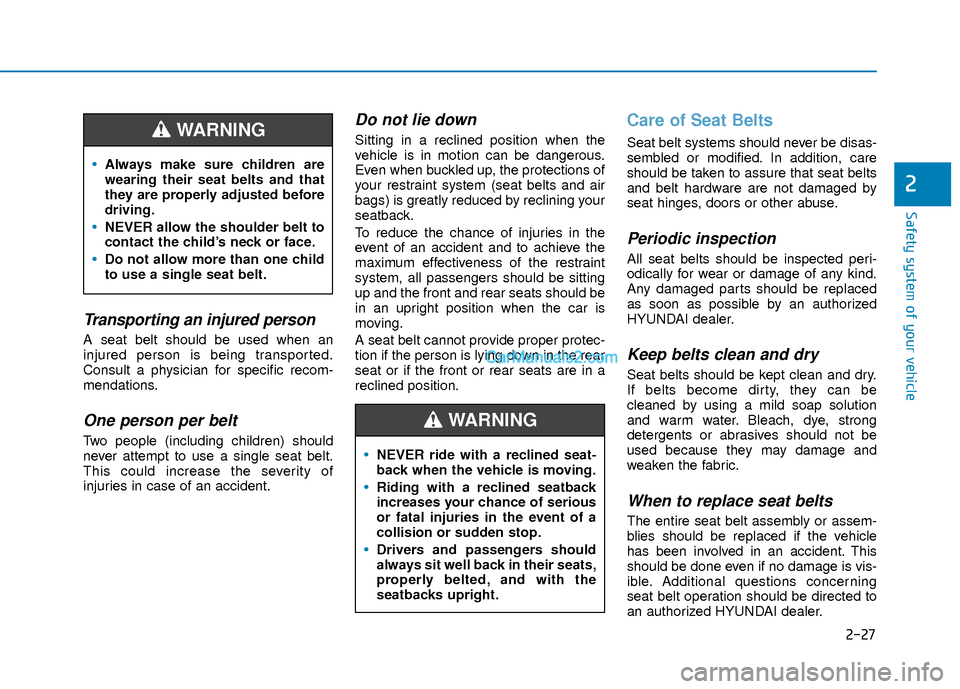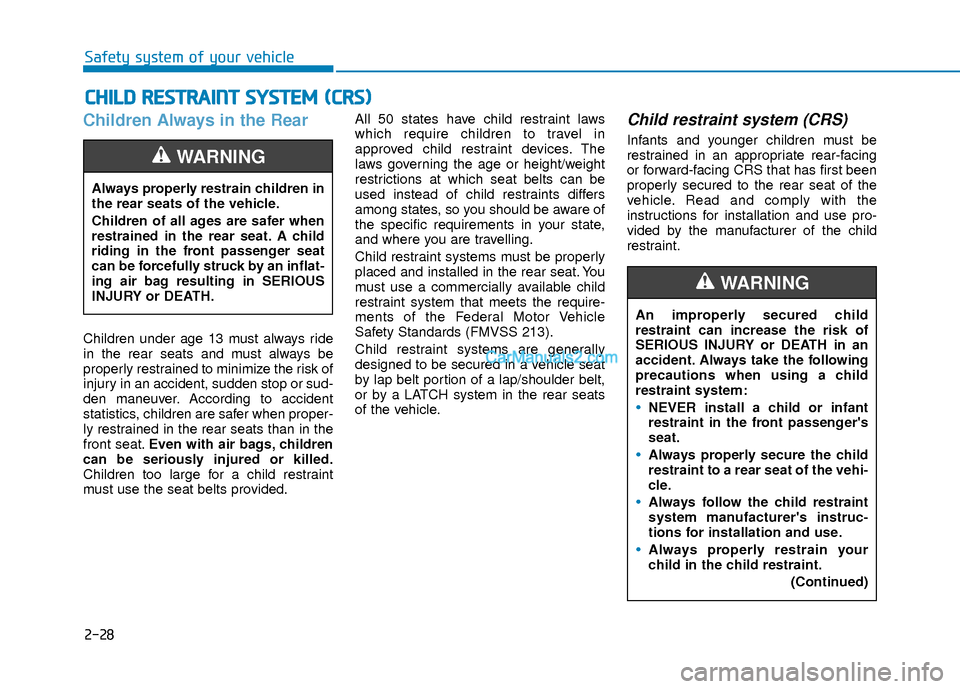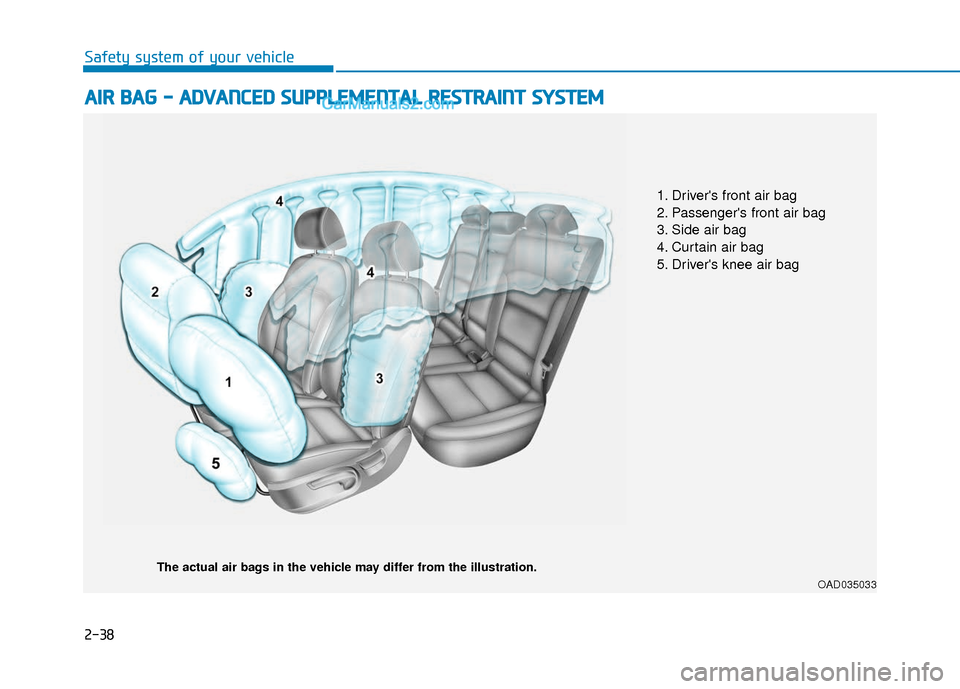2018 Hyundai Elantra Air bag
[x] Cancel search: Air bagPage 40 of 526

2-23
Safety system of your vehicle
2
Pre-tensioner seat belt (Driver and front passenger)
Your vehicle is equipped with driver's and
front passenger's Pre-tensioner Seat
Belts (Retractor Pretensioner and
Emergency Fastening Device System).
The purpose of the pre-tensioner is to
make sure the seat belts fit tightly against
the occupant's body in certain frontal col-
lisions. The Emergency Fastening Device
System may be activated in certain
crashes where the frontal collision is
severe enough, together with the air
bags. When the vehicle stops suddenly, or if
the occupant tries to lean forward too
quickly, the seat belt retractor will lock
into position. In certain frontal collisions,
the pre-tensioner will activate and pull
the seat belt into tighter contact against
the occupant's body.
(1) Retractor Pretensioner
The purpose of the retractor preten-sioner is to make sure that the shoul-
der belts fit in tightly against the occu-
pant's upper body in certain frontal
collisions.
(2) Emergency Fastening Device System The purpose of the EmergencyFastening Device System is to make
sure that the pelvis belts fit in tightly
against the occupant's lower body in
certain frontal collisions.
If the system senses excessive tension
on the driver or passenger's seat belt
when the pre-tensioner system activates,
the load limiter inside the retractor pre-
tensioner will release some of the pres-
sure on the affected seat belt.
OTL035053
Always wear your seat belt and
sit properly in your seat.
Do not use the seat belt if it is
loose or twisted. A loose or
twisted seat belt will not protect
you properly in an accident.
Do not place anything near the
buckle. This may adversely affect
the buckle and cause it to func-
tion improperly.
Always replace your pre-tension-
ers after activation or an acci-
dent.
NEVER inspect, service, repair or
replace the pre-tensioners your-
self. This must be done by an
authorized HYUNDAI dealer.
Do not hit the seat belt assem-
blies.
WARNING
Page 41 of 526

2-24
Safety system of your vehicle
The Pre-Tensioner Seat Belt System
consists mainly of the following compo-
nents. Their locations are shown in the
illustration above:
1. SRS air bag warning light
2. Retractor pre-tensioner
3. SRS control module
4. Emergency Fastening Device SystemThe sensor that activates the SRS air
bag is connected with the pre–ten-
sioner seat belts. The SRS air bag
warning light on the instrument panel
will illuminate for approximately 6 sec-
onds after the ignition switch is in the
ON position, and then it should turn
off.
If the pre-tensioner is not working
properly, the warning light will illumi-
nate even if the SRS air bag is not mal-
functioning. If the warning light does
not illuminate, stays illuminated or
illuminates when the vehicle is being
driven, have an authorized HYUNDAI
dealer inspect the pre-tensioner seat
belts and SRS air bags as soon as
possible.
NOTICE
Do not touch the pre-tensioner seat
belt assemblies for several minutes
after they have been activated.
When the pre-tensioner seat belt
mechanism deploys during a colli-
sion, the pre-tensioners become
hot and can burn you.
WARNING
OLMB033040/Q
Page 44 of 526

2-27
Safety system of your vehicle
2
Transporting an injured person
A seat belt should be used when an
injured person is being transported.
Consult a physician for specific recom-
mendations.
One person per belt
Two people (including children) should
never attempt to use a single seat belt.
This could increase the severity of
injuries in case of an accident.
Do not lie down
Sitting in a reclined position when the
vehicle is in motion can be dangerous.
Even when buckled up, the protections of
your restraint system (seat belts and air
bags) is greatly reduced by reclining your
seatback.
To reduce the chance of injuries in the
event of an accident and to achieve the
maximum effectiveness of the restraint
system, all passengers should be sitting
up and the front and rear seats should be
in an upright position when the car is
moving.
A seat belt cannot provide proper protec-
tion if the person is lying down in the rear
seat or if the front or rear seats are in a
reclined position.
Care of Seat Belts
Seat belt systems should never be disas-
sembled or modified. In addition, care
should be taken to assure that seat belts
and belt hardware are not damaged by
seat hinges, doors or other abuse.
Periodic inspection
All seat belts should be inspected peri-
odically for wear or damage of any kind.
Any damaged parts should be replaced
as soon as possible by an authorized
HYUNDAI dealer.
Keep belts clean and dry
Seat belts should be kept clean and dry.
If belts become dirty, they can be
cleaned by using a mild soap solution
and warm water. Bleach, dye, strong
detergents or abrasives should not be
used because they may damage and
weaken the fabric.
When to replace seat belts
The entire seat belt assembly or assem-
blies should be replaced if the vehicle
has been involved in an accident. This
should be done even if no damage is vis-
ible. Additional questions concerning
seat belt operation should be directed to
an authorized HYUNDAI dealer.
Always make sure children are
wearing their seat belts and that
they are properly adjusted before
driving.
NEVER allow the shoulder belt to
contact the child’s neck or face.
Do not allow more than one child
to use a single seat belt.
WARNING
NEVER ride with a reclined seat-
back when the vehicle is moving.
Riding with a reclined seatback
increases your chance of serious
or fatal injuries in the event of a
collision or sudden stop.
Drivers and passengers should
always sit well back in their seats,
properly belted, and with the
seatbacks upright.
WARNING
Page 45 of 526

2-28
Safety system of your vehicle
Children Always in the Rear
Children under age 13 must always ride
in the rear seats and must always be
properly restrained to minimize the risk of
injury in an accident, sudden stop or sud-
den maneuver. According to accident
statistics, children are safer when proper-
ly restrained in the rear seats than in the
front seat.Even with air bags, children
can be seriously injured or killed.
Children too large for a child restraint
must use the seat belts provided. All 50 states have child restraint laws
which require children to travel in
approved child restraint devices. The
laws governing the age or height/weight
restrictions at which seat belts can be
used instead of child restraints differs
among states, so you should be aware of
the specific requirements in your state,
and where you are travelling.
Child restraint systems must be properly
placed and installed in the rear seat. You
must use a commercially available child
restraint system that meets the require-
ments of the Federal Motor Vehicle
Safety Standards (FMVSS 213).
Child restraint systems are generally
designed to be secured in a vehicle seat
by lap belt portion of a lap/shoulder belt,
or by a LATCH system in the rear seats
of the vehicle.
Child restraint system (CRS)
Infants and younger children must be
restrained in an appropriate rear-facing
or forward-facing CRS that has first been
properly secured to the rear seat of the
vehicle. Read and comply with the
instructions for installation and use pro-
vided by the manufacturer of the child
restraint.
C C
H
H I
IL
L D
D
R
R E
ES
ST
T R
R A
A I
IN
N T
T
S
S Y
Y S
ST
T E
EM
M
(
( C
C R
R S
S)
)
Always properly restrain children in
the rear seats of the vehicle.
Children of all ages are safer when
restrained in the rear seat. A child
riding in the front passenger seat
can be forcefully struck by an inflat-
ing air bag resulting in SERIOUS
INJURY or DEATH.
WARNING
An improperly secured child
restraint can increase the risk of
SERIOUS INJURY or DEATH in an
accident. Always take the following
precautions when using a child
restraint system:
NEVER install a child or infant
restraint in the front passenger's
seat.
Always properly secure the child
restraint to a rear seat of the vehi-
cle.
Always follow the child restraint
system manufacturer's instruc-
tions for installation and use.
Always properly restrain your
child in the child restraint.
(Continued)
WARNING
Page 46 of 526

2-29
Safety system of your vehicle
2
Selecting a Child Restraint
System (CRS)
When selecting a CRS for your child,
always:
Make sure the CRS has a label certify-ing that it meets applicable Federal
Motor Vehicle Safety Standards
(FMVSS 213).
Select a child restraint based on your child’s height and weight. The required
label or the instructions for use typical-
ly provide this information.
Select a child restraint that fits the vehicle seating position where it will be
used.
Read and comply with the warnings and instructions for installation and use
provided with the child restraint sys-
tem.
Child restraint system types
There are three main types of child
restraint systems: rear-facing seats, for-
ward-facing seats, and booster seats.
They are classified according to the
child’s age, height and weight.
Rear-facing child seats
(Continued)
If the vehicle head restraint pre-
vents proper installation of a
child seat (as described in the
child restraint system manual),
the head restraint of the respec-
tive seating position shall be
readjusted or entirely removed.
Do not use an infant carrier or a
child safety seat that "hooks"
over a seatback, it may not pro-
vide adequate protection in an
accident.
After an accident, have a
HYUNDAI dealer check the child
restraint system, seat belts, teth-
er anchors and lower anchors.
NEVER install a child or infant
restraint in the front passenger’s
seat.
Placing a rear-facing child restraint
in the front seat can result in SERI-
OUS INJURY or DEATH if the child
restraint is struck by an inflating air
bag.
WARNING
Page 52 of 526

2-35
Safety system of your vehicle
2
To install the tether anchor:
1. Route the child restraint tether strapover the child restraint seatback.
Route the tether strap under the head
restraint and between the head
restraint posts, or route the tether
strap over the top of the vehicle seat-
back. Make sure the strap is not twist-
ed.
2. Connect the tether strap hook to the tether anchor, then tighten the tether
strap according to the child seat man-
ufacturer’s instructions to firmly
secure the child restraint to the seat.
3. Check that the child restraint is securely attached to the seat by push-
ing and pulling the seat forward-and-
back and side-to-side.
Securing a child restraint withlap/shoulder belt
When not using the LATCH system, all
child restraints must be secured to a
vehicle rear seat with the lap part of a
lap/shoulder belt.
Automatic locking mode
Since all passenger seat belts move
freely under normal conditions and only
lock under extreme or emergency condi-
tions (emergency locking mode), you
must manually pull the seat belt all the
way out to shift the retractor to the
"Automatic Locking" mode to secure a
child restraint.
The "Automatic Locking" mode will help
prevent the normal movement of the
child in the vehicle from causing the seat
belt to loosen and compromise the child
restraint system. To secure a child
restraint system, use the following proce-
dure.
OLF034035
ALWAYS place a rear-facing child
restraint in the rear seat of the vehi-
cle.
Placing a rear-facing child restraint
in the front seat can result in seri-
ous injury or death if the child
restraint is struck by an inflating air
bag.
WARNING
OLMB033044
Page 55 of 526

2-38
Safety system of your vehicle
A
AI
IR
R
B
B A
A G
G
-
-
A
A D
DV
VA
A N
N C
CE
E D
D
S
S U
U P
PP
PL
LE
E M
M E
EN
N T
TA
A L
L
R
R E
ES
ST
T R
R A
A I
IN
N T
T
S
S Y
Y S
ST
T E
EM
M
OAD035033
The actual air bags in the vehicle may differ from the illustration.
1. Driver's front air bag
2. Passenger's front air bag
3. Side air bag
4. Curtain air bag
5. Driver's knee air bag
Page 56 of 526

2-39
Safety system of your vehicle
2
This vehicle is equipped with an
Advanced Supplemental Air Bag System
for the driver's seat and front passenger's
seats.
The front air bags are designed to sup-
plement the three-point seat belts. For
these air bags to provide protection, the
seat belts must be worn at all times when
driving.
You can be severely injured or killed in an
accident if you are not wearing a seat
belt. Air bags are designed to supple-
ment seat belts, but do not replace them.
Also, air bags are not designed to deploy
in every collision. In some accidents, the
seat belts are the only restraint protect-
ing you.AIR BAG SAFETY PRECAUTIONS
ALWAYS use seat belts and child restraints - every trip, every time, everyone!
Even with air bags, you can be seriously injured or killed in a collision if you
are improperly belted or not wearing your seat belt when the air bag inflates.
NEVER place a child in any child restraint or booster seat in the front pas-
senger seat. An inflating air bag could forcefully strike the infant or child
causing serious or fatal injuries.
ABC - Always Buckle Children under age 13 in the back seat. It is the safest
place for children of any age to ride. If a child age 13 or older must be seated
in the front seat, he or she must be properly belted and the seat should be
moved as far back as possible.
All occupants should sit upright with the seatback in an upright position, cen-
tered on the seat cushion with their seat belt on, legs comfortably extended
and their feet on the floor until the vehicle is parked and the engine is turned
off. If an occupant is out of position during an accident, the rapidly deploying
air bag may forcefully contact the occupant causing serious or fatal injuries.
You and your passengers should never sit or lean unnecessarily close to the
air bags or lean against the door or center console.
Move your seat as far back as possible from front air bags, while still main-
taining control of the vehicle. The U.S. National Highway Traffic Safety
Administration (NHTSA) recommends that drivers allow at least 10 inches (25
cm) between the center of the steering wheel and the chest.WARNING